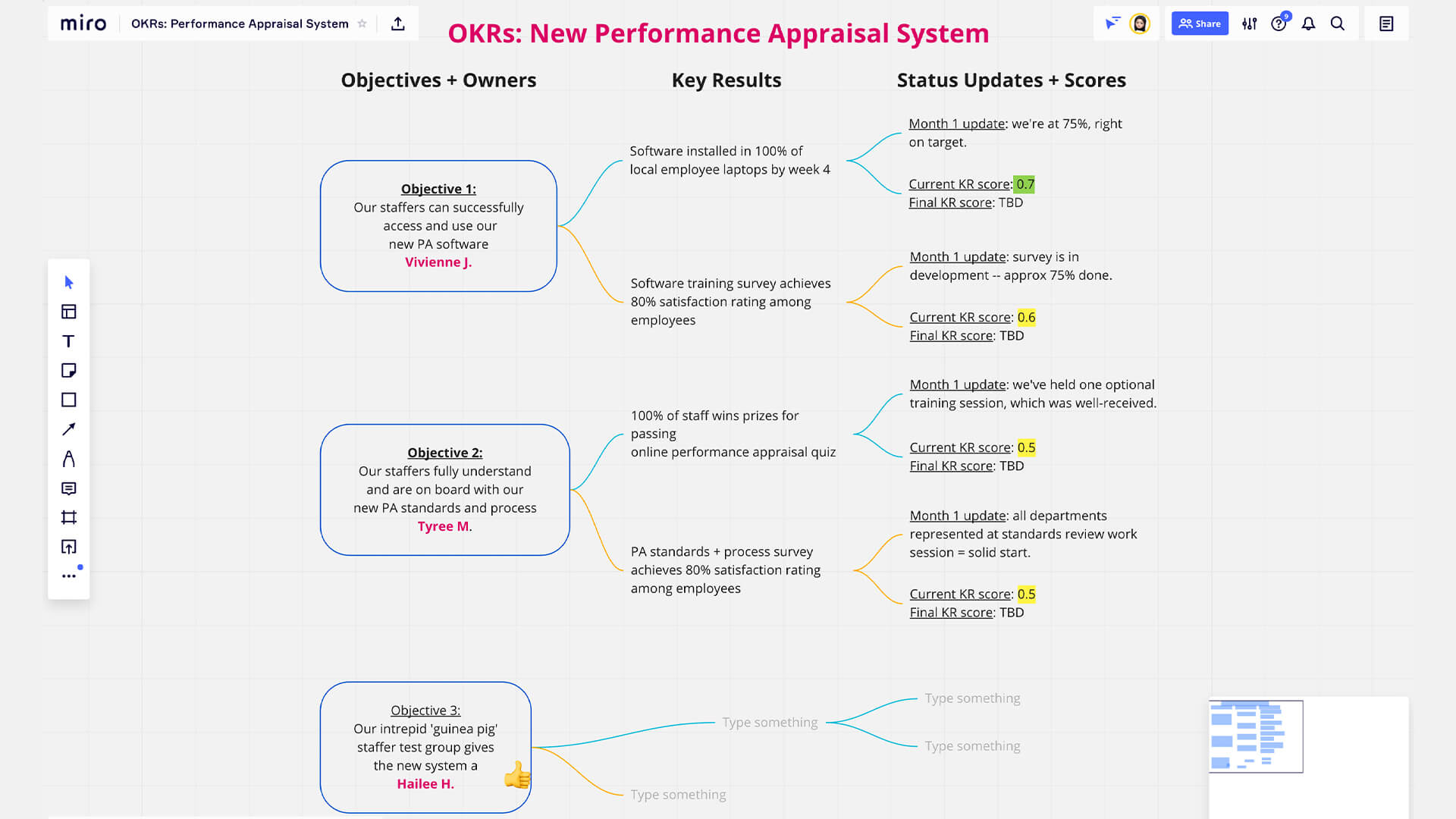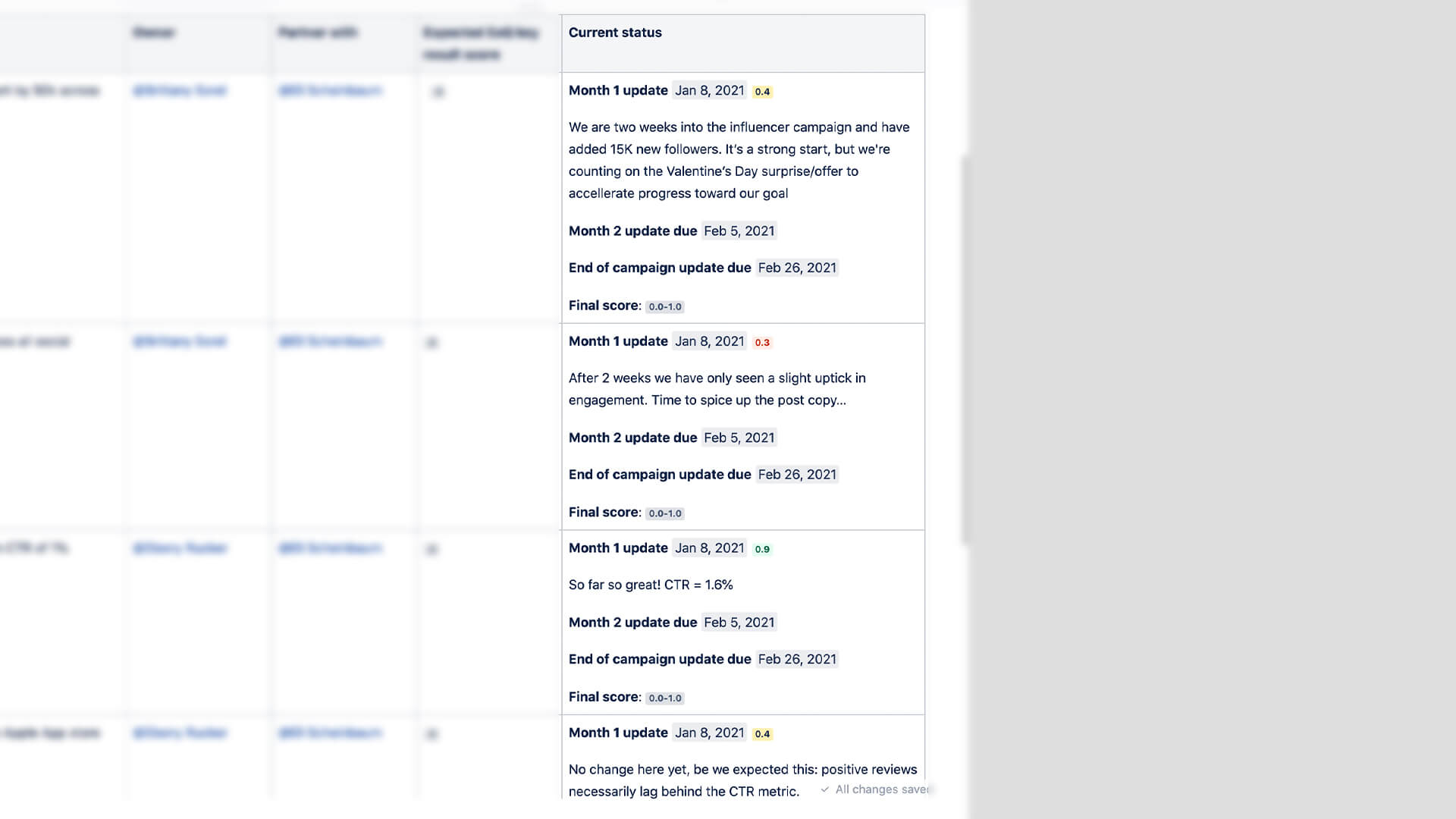Objectives and Key Results (OKRs)
Use the OKR goal-setting framework to define objectives, establish key results, and accelerate progress toward achieving your organizational and team goals.

PREP TIME
10m
Run TIME
2h
Persons
3-11
5-second summary
- Define 1-3 objectives.
- Set 3-5 key results per objective.
- Track success and score your OKRs each month.
WHAT YOU WILL NEED
- Video conferencing with screen sharing or meeting space.
- Digital collaboration tool (see templates).
- Timer.
PLAY resources
How to set OKRs
The OKR Play shares a five-step process that any team can follow to define objectives, articulate desired results, and track success with OKRs.
OKR (目標と主要な成果) とは
John Doerr 氏は著書『Measure What Matters (メジャー・ホワット・マターズ)』で OKR を紹介し、目標を「やるべきこと」、主要な成果を「方法」と表現しています。これについて詳しく説明しましょう。
目標では、達成したいことを説明し、方向性や目的を示します。通常は質的・野心的で、行動を促す役割を果たします。
主要な成果では、具体的で測定可能な結果によって目標を達成する方法を詳細に示します。主要な成果は定量的で、目標に向けた進捗を追跡し、通常は明確な指標やマイルストーンが設定されます。
OKR は、組織全体に導入すると最も強力になります。OKR は複数のチームや個人とつながっているためです。
OKR プレイを実行する理由
OKR プレイを実行する、説得力のある理由が次の 2 つです。
- 重要なことを決定する: OKR では、優先事項は何か、自分の作業が組織の目標にどのように貢献するかを明確に示します。
- 重要でないことを決定する: 優先事項ではないことを OKR で明確に示します。これにより、チームが限られた優先事項に集中し、主要な作業を妨げるタスクを拒否できるようにします。
OKR によって、チームは目標を中心に連携し、透明性が高まり、説明責任を促し、成功を測定するための明確な枠組みが得られます。OKR を適切に導入すると、組織全体のパフォーマンスとコラボレーションが向上します。
職場で OKR を使用するタイミング
成長時、変更時、または組織全体で透明性や説明責任を改善する必要がある場合に、OKR は特に有用です。アトラシアン チームは毎年 OKR を設定し、四半期ごとに更新して、毎月進捗を追跡しています。
OKR がもたらす 3 つのメリット
- 好影響: アンケート参加者の 83% が、OKR は組織に好影響を及ぼし、それが継続していると回答しています (OKR インパクト レポート 2022)。
- 生産性向上と目標達成: 作業に優先順位を付けているチームは、効果的かつ生産的になる可能性が 4.6 倍高くなります (アトラシアンのチーム状況レポート 2024)。
- アジリティと適応性: OKR により、目標を迅速に調整できるため、企業は迅速に変化に適応できます。主要な目標を特定することで、企業の適応できる確率が 4.7 倍高くなります (アトラシアンのチーム状況レポート 2024)。
1. Prep the Play
1. プレイの準備をする 5 分
対面でもリモートでも、チームで集まる際には、プレイの概要と、プレイを実行する理由を説明するメッセージを送信します。次に、Confluence ページなどの、コラボレーション ドキュメントを作成します。提供されたテンプレートを利用するか、独自のテンプレートを作成できます。
チームで OKR を設定する期間を決め (最初は四半期にするのが良いでしょう)、プレイを実行する前に次の情報を共有します。
- より広範な会社の目標と目的
- プロジェクト ロードマップ
- 顧客の指標やフィードバック
-
利用可能な場合は、以前の OKR
ヒント: トップによる指導
会社に OKR がない場合は、会社が注力する年度の戦略的イニシアチブや優先事項を探します。これらから情報を得て、チームで OKR を作成します。
2. Define objectives
1. プレイの準備をする 5 分
目標、つまり定義した期間で達成するやるべきことに関して、チームにブレーンストーミングしてもらいます。目標は質的かつ野心的である必要があり、目標を設定している間はチームの最優先事項になります。
アイデアをコラボレーション ドキュメントに追加します。同様の目標をまとめてから、アイデアを 1 - 3 つの目標にまとめます。
1. 顧客満足度を向上させる
2. 製品開発を加速する
3. 市場での活動範囲を拡大する
4. チームの生産性を高める
5. 将来に向けて構築する
6. ユーザーの心をつかむ
7. AI 企業になる
8. 優先度の高い製品への取り組みを促進する
9. ビジネス チームの導入を拡大する
10. 売上収益を増やす
3. Set key results
1. プレイの準備をする 5 分
各メンバーに、このプロジェクトで自分が担当する責任のうち重要なもの 3-5 個を「(自分が思う) 責任」列に記入してもらいます。
1. 目標: 顧客満足度を向上させる
- 主要な成果 1: NPS (ネット プロモーター スコア) 50 以上を達成する
- 主要な成果 2: 顧客からの問い合わせに対する平均応答時間を 2 時間未満に短縮する
-
主要な成果 3: 顧客の定着率を 10% 向上させる
2. 目標: 製品開発を加速する
- 主要な成果 1: 第 4 四半期末までに新機能を 2 つリリースする
- 主要な成果 2: バグの平均解決時間を 25% 短縮する
-
主要な成果 3: 自動テストの割合を 80% に増やす
3. 目標: 市場での活動範囲を拡大する
- 主要な成果 1: 年末までに新しい地理的市場 3 か所に参入する
- 主要な成果 2: ターゲット市場でのブランド認知度を 20% 向上させる
-
主要な成果 3: 主要なインフルエンサー 5 人または組織 5 社とのパートナーシップを確保する
ヒント: タスクではなく結果
KR は作業の尺度であり、作業そのものではありません。
「Web ページを 5 つ作成する」は、作業です。
「ページ ビュー数が 5% 増加」は、主要な成果です。
ヒント: 品質を守る
KR により、生産物と品質のどちらも得られるようにします。たとえば、KR がヘルプ デスクの解決済みのチケット数である場合、提出されたチケット数の減少も測定して、サポートの質を維持するようにします。品質を低下させても KR を達成するということが目標ではありません。
4. Assign owners
1. プレイの準備をする 5 分
記入された他のメンバーの役割それぞれについて、あなたがその役割の重要な責任だと考えるものを「(他者が思う) 責任」列に記入します。
役割に明確にあてはまらない責任を思いついた場合は、「未割り当ての責任」セクションにその役割を追加します。
5. Tracking success with OKRs
1. プレイの準備をする 5 分
他のメンバーがあなたの役割について「(他者が思う) 責任」列に記入した内容を確認します。各責任について、それを受け入れる場合は ✅ を、受け入れない場合は ❌ を追加します。
他のメンバーの責任について質問やコメントがある場合は、インライン コメントを追加します。
チーム ディスカッションの後で、役割の所有者がすべての ❌ を確認し、追加の責任を引き受けるか委任するかを決定します。タスクが重複する場合は、主となる所有者と、貢献者またはバックアップ所有者が指名されます。
誰にも割り当てられていないか引き受けられていない責任は、未割り当ての責任セクションに移動されます。
組織構造によっては、役割の所有者がリーダーからの承認を得て、このプロセスで特定された役割を確定する必要がある場合があります。
Follow-up
共有
最終文書をチームと共有し、潜在的なギャップや機会についてのフィードバックを収集します。
役割と責任に関する文書を主要な関係者とリーダーに配布し、配布したことをチームに伝えます。
3 か月または 6 か月ごと、またはチーム内で重大な変化があった場合に、チームでこのプレイを見直すことを計画してください。定期的に実施することで、より円滑に行えるようになります。

その他のご質問がある場合は、
他の Atlassian Team Playbook のユーザーと会話を開始したり、サポートを受けたり、フィードバックを提供したりできます。
Other plays you may like
意思決定
DACI 意思決定フレームワーク
意思決定プロセスで効果的なコラボレーションと説明責任を確保するために、明確な役割を割り当ててください。
意思決定
トレードオフ
プロジェクトの可変要素を定義して優先順位を付けます。
Goal-setting
Modeling Strategic Focus Areas
Build and align on your organization’s strategic focus areas.
最新に保つ
ニュースレターにサインアップすると、プレイや Work Life に関する最新のアドバイスを入手できます。










